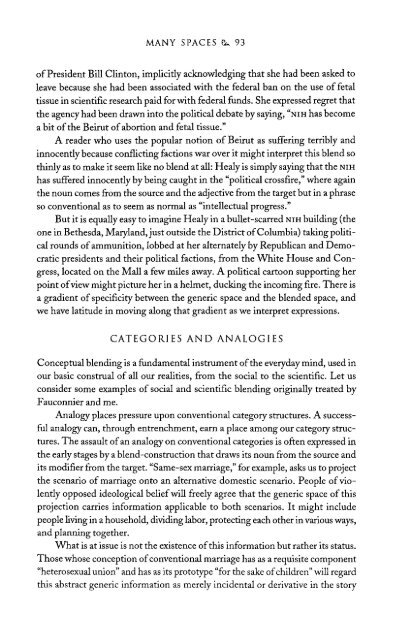The Literary Mind.pdf
The Literary Mind.pdf
The Literary Mind.pdf
Create successful ePaper yourself
Turn your PDF publications into a flip-book with our unique Google optimized e-Paper software.
MANY SPACES 93<br />
of President Bill Clinton, implicitly acknowledging that she had been asked to<br />
leave because she had been associated with the federal ban on the use of fetal<br />
tissue in scientific research paid for with federal funds. She expressed regret that<br />
the agency had been drawn into the political debate by saying, "NIH has become<br />
a bit of the Beirut of abortion and fetal tissue."<br />
A reader who uses the popular notion of Beirut as suffering terribly and<br />
innocently because conflicting factions war over it might interpret this blend so<br />
thinly as to make it seem like no blend at all: Healy is simply saying that the NIH<br />
has suffered innocently by being caught in the "political crossfire," where again<br />
the noun comes from the source and the adjective from the target but in a phrase<br />
so conventional as to seem as normal as "intellectual progress."<br />
But it is equally easy to imagine Healy in a bullet-scarred NIH building (the<br />
one in Bethesda, Maryland, just outside the District of Columbia) taking political<br />
rounds of ammunition, lobbed at her alternately by Republican and Democratic<br />
presidents and their political factions, from the White House and Congress,<br />
located on the Mall a few miles away. A political cartoon supporting her<br />
point of view might picture her in a helmet, ducking the incoming fire. <strong>The</strong>re is<br />
a gradient of specificity between the generic space and the blended space, and<br />
we have latitude in moving along that gradient as we interpret expressions.<br />
CATEGORIES AND ANALOGIES<br />
Conceptual blending is a fundamental instrument of the everyday mind, used in<br />
our basic construal of all our realities, from the social to the scientific. Let us<br />
consider some examples of social and scientific blending originally treated by<br />
Fauconnier and me.<br />
Analogy places pressure upon conventional category structures. A successful<br />
analogy can, through entrenchment, earn a place among our category structures.<br />
<strong>The</strong> assault of an analogy on conventional categories is often expressed in<br />
the early stages by a blend-construction that draws its noun from the source and<br />
its modifier from the target. "Same-sex marriage," for example, asks us to project<br />
the scenario of marriage onto an alternative domestic scenario. People of violently<br />
opposed ideological belief will freely agree that the generic space of this<br />
projection carries information applicable to both scenarios. It might include<br />
people living in a household, dividing labor, protecting each other in various ways,<br />
and planning together.<br />
What is at issue is not the existence of this information but rather its status.<br />
Those whose conception of conventional marriage has as a requisite component<br />
"heterosexual union" and has as its prototype "for the sake of children" will regard<br />
this abstract generic information as merely incidental or derivative in the story















